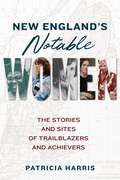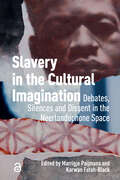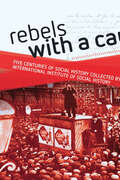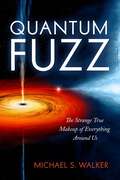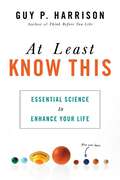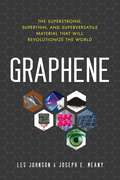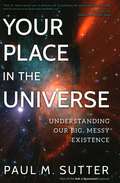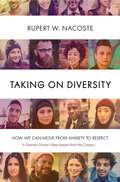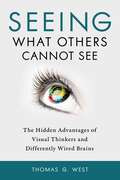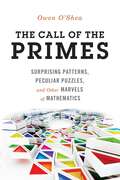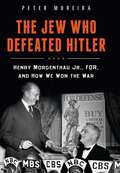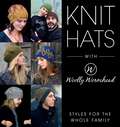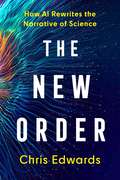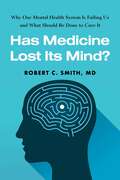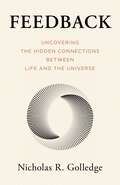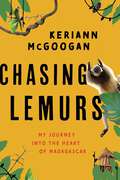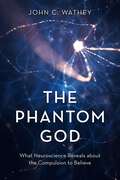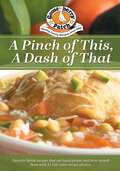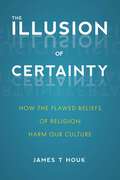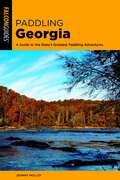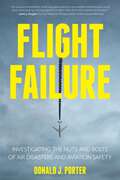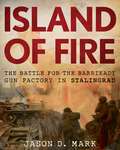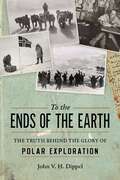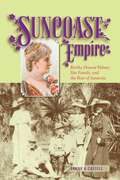- Table View
- List View
New England's Notable Women: The Stories and Sites of Trailblazers and Achievers
by Patricia HarrisNew England has nurtured countless women who shook off traditional gender roles to forge their own destinies. Their achievements are legion. Narragansett tribal historian Princess Red Wing served as a delegate to the United Nations and co-founded Rhode Island&’s Tomaquag Museum. Boston iconoclast Isabella Stewart Gardner had the acute artistic vision to establish the museum that bears her name. Harriet Beecher Stowe ignited public opinion against slavery, arguably hastening the Civil War, as displays in her Hartford home make clear. Pioneering naturalist Rachel Carson jumpstarted the modern environmental movement with her writings about the rocky beaches and quivering tidepools of Southport, Maine. New England's Notable Women shines the spotlight on 45 of these trailblazers and achievers and directs readers to the homes and sites throughout New England where their stories come to life.
Slavery in the Cultural Imagination: Debates, Silences, and Dissent in the Neerlandophone Space (Slavery and Emancipation)
by Karwan Fatah-Black Marrigje PaijmansWith the rising tide of scholarly and societal interest in the history and legacy of colonialism and slavery, this collection offers a much-needed diachronic analysis of the cultural representations of the lives and afterlives of those subjected to slavery and indenture. It focuses on the history of the ‘neerlandophone’ space, defined as the complex linguistic space spanning former Dutch colonies. This collection gives a longue durée overview, with cases from the early modern period to the present day, revealing the deep roots of the colonial ‘cultural archive’. Scholars from a wide variety of disciplines demonstrate how attention to the layered and polyphonic qualities of narratives can reveal silent and disruptive voices in colonial discourse, as well as collective emotions and imaginations that have hitherto remained unrecorded in historical sources. They discuss different aesthetic, poetic, and storytelling practices, including literature, archival and legal documents, performance, architecture, photography, and philosophy, formed both in the metropolis and by enslaved and indentured peoples in the colonies.
Rebels with a cause: Five centuries of social history collected by the International Institute of Social History
by Jan Lucassen Jaap KloostermanEvery age has had its rebels: socialists, peace activists, sexual reformers, fundamentalists, and more. The collections of the International Institute of Social History (IISH) in Amsterdam are full of them. The IISH is the world's largest documentation centre in the field of social history and emancipation movements. This book looks back on seventy-five years of the IISH and its collections, with a focus on creative ideas and people who fought for radical change, from Karl Marx to Aung San Suu Kyi, the French Revolution to the Chinese student revolt of 1989, from the early modern world explorers to today's anti-globalists.
Quantum Fuzz: The Strange True Makeup of Everything Around Us
by Michael S. WalkerQuantum physics has turned our commonsense notion of reality on its head. This accessible book describes in layperson's terms the strange phenomena that exist at the quantum level--a world of tiny dimensions where nothing is absolutely predictable, where we rethink causality, and information seemingly travels faster than light. The author, a veteran physicist, uses illuminating analogies and jargon-free language to illustrate the basic principles of the subatomic world and show how they explain everything from the chemistry around us to the formation of galaxies. He also explains how scientists and engineers interact with this nebulous reality and, despite its mysteries, achieve results of great precision.Up front is a brief history of the early 20th-century "quantum revolution," focusing on some of the brilliant individuals whose contributions changed our view of the world--Albert Einstein, Niels Bohr, Paul Dirac, Werner Heisenberg, Erwin Schroedinger, and others. The work concludes with a discussion of the many amazing inventions that have resulted from quantum theory, including lasers, semiconductors, and the myriad of electronic devices that use them.Lucidly written, this book conveys the excitement of discovery while expanding the reader's appreciation for a science that explores the basis of everything we know.
At Least Know This: Essential Science to Enhance Your Life
by Guy P. HarrisonThis primer on essential scientific literacy gives readers the basics to understand themselves and the world around them, plus a glimpse of how much more science has to offer. Science tells us a good deal about who we are, where we come from, the nature of the universe, how our brains work, and much, much more. Unfortunately, most people are largely unaware of this treasure trove of information. As a result, we are more prone to do things like aim nuclear weapons at each other, inflate the meaning of cultural differences, lay waste to the land, poison and deplete the oceans, fill the sky with carbon, and generally make poor judgments that cause needless trouble. This book seeks to remedy this situation by providing scientific answers to the most basic yet important questions about existence. Following the standard six-question list used by journalists researching a news story, critical-thinking advocate Guy P. Harrison turns to science to answer the who, what, why, when, where and how of life on Earth. How old is our planet? Where did it come from and where is it located in the universe? What is everything made of? When did life begin? Who are we as a species and what connections do we share with other life forms? Why is human culture continuously plagued by war, disease, and crime? Harrison not only offers science's best current answers to these crucial questions but shows how all of this information fits together. Going well beyond the simplistic factoids readily available on any smartphone, he reveals the wider implications and deeper meanings inherent in the scientific worldview. Both entertaining and informative, this exciting tour of the cosmos and human nature will leave readers with an accurate, up-to-date view of realities small and large, near and far.
Graphene: The Superstrong, Superthin, and Superversatile Material That Will Revolutionize the World
by Les Johnson Joseph E. MeanyTwo scientists give an enthusiastic, layperson's overview of a new supermaterial now in development that could transform many features of daily life, from creating new conveniences to improving health and safety. What if you discovered an infinitesimally thin material capable of conducting electricity, able to suspend millions of times its own weight, and yet porous enough to filter the murkiest water? And what if this incredible substance is created from the same element that fills the common pencil? That's graphene--a flat, two-dimensional, carbon-based molecule with a single sheet measuring only one atom thick. In this layperson's introduction to this revolutionary substance, a physicist and a chemist explain how graphene was developed, discuss the problems in scaling up production for large-scale commercial use, and forecast the potentially transformative effects of incorporating graphene into everyday life. Recent research developments include adding graphene to Silly Putty to make extremely sensitive and malleable medical sensors and compressing and fusing flakes of graphene to create a three-dimensional material that's ten times stronger than steel. This widely adaptable substance promises to change the way we interact with smartphones, laptops, information storage, and even condoms. It may also enable significant improvements to air purification, water filtration technologies, and drug delivery. This entertaining and widely accessible book offers a fascinating look into one of the most exciting developments in materials science in recent decades.
Your Place in the Universe: Understanding Our Big, Messy Existence
by Paul M. SutterAn astrophysicist presents an in-depth yet accessible tour of the universe for lay readers, while conveying the excitement of astronomy. How is a galaxy billions of lightyears away connected to us? Is our home nothing more than a tiny speck of blue in an ocean of night? In this exciting tour of a universe far larger than we can imagine, cosmologist Paul M. Sutter emphasizes how amazing it is that we are part of such a huge, complex, and mysterious place. Through metaphors and uncomplicated language, Sutter breathes life into the science of astrophysics, unveiling how particles, forces, and fields interplay to create the greatest of cosmic dramas. Touched with the author's characteristic breezy, conversational style--which has made him a breakout hit on venues such as The Weather Channel, the Science Channel, and his own popularAsk a Spaceman!podcast--he conveys the fun and wonder of delving deeply into the physical processes of the natural universe. He weaves together the past and future histories of our universe with grounded descriptions of essential modern-day physics as well as speculations based on the latest research in cosmology. Topics include our place in the Milky Way galaxy; the cosmic web--a vast web-like pattern in which galaxies are arranged; the origins of our universe in the big bang; the mysteries of dark matter and dark energy; how science has dramatically changed our relationship to the cosmos; conjectures about the future of reality as we know it; and more. For anyone who has ever stared at the starry night sky and wondered how we humans on Earth fit into the big picture, this book is an essential roadmap.
Taking on Diversity: How We Can Move from Anxiety to Respect
by Rupert W. NacosteIn this enlightening book, a campus "diversity doctor" relatesstories that individuals have shared with him about their anxieties in situations involving people who are in some way different than themselves. Dr. Rupert W. Nacoste regularly counsels students at North Carolina State University about their problems dealing with diversity of all kinds, including of gender, race, ethnicity, and sexual-orientation. Here, he shares his most effective techniques for handling the unavoidable realities of being in a neo-diverse community, whether that means in college or America as a nation. The author's proven "safe space" strategy can be applied to the campus, community groups, churches, and workplaces as a means to facilitate positive dialogue about diversity. In this time of current tensions, students, or "young travelers" as Nacoste fondly refers to them, still have much work ahead of them to achieve mutual respect and understanding. From everyday encounters, parties, and email and social media exchanges, they provide examples of ongoing bigotry: racial slurs and stereotypes are still used; young men continue to project demeaning attitudes toward women; and the heterosexual majority sometimes shows little understanding of the LBGT minority. Dr. Nacoste considers it his role to usher students off the "Wrong-Line train," and he has noticed that as they "leave the station," adults begin to follow their lead. The author demonstrates how we can maintain fairness and respect while still acknowledging our differences. By doing so, we can all learn to meet these challenges using sensitivity to different perspectives, open-minded attitudes, and the recognition that diversity in America is here to stay.
Seeing What Others Cannot See: The Hidden Advantages of Visual Thinkers and Differently Wired Brains
by Thomas G. WestFor over 25 years, Thomas G. West has been a leading advocate for the importance of visual thinking, visual technologies and the creative potential of individuals with dyslexia and other learning differences. In this new book, he investigates how different kinds of brains and different ways of thinking can help to make discoveries and solve problems in innovative and unexpected ways. West focuses on what he has learned over the years from a group of extraordinarily creative, intelligent, and interesting people — those with dyslexia, Asperger's syndrome, and other different ways of thinking, learning, and working. He shows that such people can provide important insights missed by experts as they also can prevent institutional "group think." Based on first-person accounts, West tells stories that include a dyslexic paleontologist in Montana, a special effects tech who worked for Pink Floyd and Kiss and who is now an advocate for those with Asperger's syndrome, a group of dyslexic master code breakers in a British electronic intelligence organization, a Colorado livestock handling expert who has become a forceful advocate for those with autism and a family of dyslexics and visual thinkers in Britain that includes four winners of the Nobel Prize in Physics. He also discusses persistent controversies and the unfolding science. This is an inspiring book that not only documents the achievements of people with various learning differences, but reveals their great potential — especially in a new digital age where traditional clerical and academic skills are less and less important while an ability to think in pictures and to understand patterns using high-level computer information visualizations is rapidly increasing in value in the global economic marketplace.
Call of the Primes: Surprising Patterns, Peculiar Puzzles, and Other Marvels of Mathematics
by Owen O'SheaThis sampler of entertaining mathematical diversions reveals the elegance and extraordinary usefulness of mathematics for readers who think they have no aptitude for the subject. If you like any kind of game at all, you'll enjoy the amazing mathematical puzzles and patterns presented here in straightforward terms that any layperson can understand. From magic squares and the mysterious qualities of prime numbers to Pythagorean triples, probability theory, the Fibonacci sequence, and more, the author shows that math can be fun while having some profound implications. Such ubiquitous mathematical entities as pi and the Fibonacci numbers are found throughout the natural world and are also the foundation of our technological civilization. By exploring the intriguing games presented here, you'll come away with a greater appreciation for the beauty and importance of these and many more math concepts. This is the perfect book for people who were turned off by math in school but now as adults wonder what they may have missed.
Jew Who Defeated Hitler: Henry Morgenthau Jr., FDR, and How We Won The War
by Peter MoreiraPresident Franklin D. Roosevelt coined the slogan "The Arsenal of Democracy" to describe American might during the grim years of World War II. The man who financed that arsenal was his Secretary of the Treasury, Henry Morgenthau Jr. This is the first book to focus on the wartime achievements of this unlikely hero-a dyslexic college dropout who turned himself into a forceful and efficient administrator and then exceeded even Roosevelt in his determination to defeat the Nazis. Based on extensive research at the FDR Library in Hyde Park, NY, author Peter Moreira describes Morgenthau's truly breathtaking accomplishments: He led the greatest financial program the world has ever seen, raising $310 billion (over $4.8 trillion in today's dollars) to finance the war effort. This was largely done without the help of Wall Street by appealing to the patriotism of the average citizen through the sale of war bonds. In addition, he championed aid to Britain before America entered the war; initiated and oversaw the War Refugee Board, spearheading the rescue of 200,000 Jews from the Nazis; and became the architect of the 1944 Bretton Woods Conference, which produced the modern economic paradigm. The book also chronicles Morgenthau's many challenges, ranging from anti-Semitism to the postwar "Morgenthau Plan" that was his undoing. This is a captivating story about an understated and often overlooked member of the Roosevelt cabinet who played a pivotal role in the American war effort to defeat the Nazis.
Knit Hats with Woolly Wormhead: Styles for the Whole Family
by Woolly WormheadInternational hat-knitting icon Woolly Wormhead is known for her unique, innovative hat designs and is followed the world over by avid fans. This collection of her work includes patterns for 22 of her designs: 12 patterns for women, 5 men&’s designs, and 5 hats for kids. The special elements in her designs—such as cables, textures, and colorwork—mixed with the &“how'd she do that&” types of construction she is famous for, are what set her designs apart and make them extra-fun to knit. In this book, Woolly also gives plenty of hat-knitting tips, as well as helpful hints on how to choose your most flattering hat style. Grab some gorgeous yarn, choose a favorite hat pattern, and cast on!
The New Order: How AI Rewrites the Narrative of Science
by Chris EdwardsWhat if the great discoveries of science came in the &“wrong&” order? The Laws of Thermodynamics were discovered well after the creation of algebra, classical physics, and chemistry, but are perhaps much more important to our basic understanding of the universe. This flawed chronology led to a confusion that has prevented a cross-curricular understanding of the sciences. With the development of Artificial Intelligence, it will soon be possible to solve the philosophical and biological problem of solipsism, the problem that all of our scientific discoveries have been necessarily – and incorrectly – built upon anachronistic foundations. In other words, we&’ve built our fundamental understanding of science out of order. In The New Order: How AI Rewrites the Narrative of Science, Chris Edwards shows that AI will be able to understand science outside of the traditional l chronological developments of the sciences, unlocking entirely new potentials and perspectives on the universe. If human scholars are to understand how AI interprets the universe, we will first need to understand the scientific narrative in a &“new order.&” Moving through the dawn scientific history to modern quantum physics, Edwards frames a &“new order&” to place thermodynamics in its proper place at the center of our scientific universe. AI is likely to view the history of the universe through entropy and probability, and with the insights and invention of The New Order, readers can, too.
Crochet Slouchy Hats and Beanies: 14 Quick and Easy Patterns
by Julie KingKeep warm while looking your best with these quick and easy crocheted hat designs! Whether you prefer a slouchy hat, a beanie, or the author's favorite hybrid, the slouchy-beanie, you are sure to find a favorite in these 14 unique and colorful patterns. Make several in your favorite hues, and you'll have a hat to match whatever you wear. Great for gifts, too! A variety of stitch patterns keep the work interesting, and detailed instructions ensure success.
Has Medicine Lost Its Mind?: Why Our Mental Health System Is Failing Us and What Should Be Done to Cure It
by Robert C. SmithOne in four Americans suffer from mental illness, yet 75% receive no treatment at all - discover why our healthcare system is failing millions and learn how we can fix it. In this groundbreaking examination of America's mental health crisis, internationally recognized physician Dr. Robert C. Smith exposes the devastating gap between physical and mental health treatment. Drawing on decades of clinical experience and evidence-based research, he reveals how the historical mind-body split in medicine has created a two-tier system of care with catastrophic consequences. Key revelations include: Why medical schools fail to properly train physicians in mental health care How untreated mental illness costs society hundreds of billions in preventable healthcare expenses The hidden toll on families and communities when depression, anxiety, and substance abuse go untreated A practical roadmap for reform that puts mental health care on equal footing with physical medicine Written with both scientific rigor and compassionate insight, this urgent call to action provides policymakers, healthcare leaders, and concerned citizens with a clear path forward. Dr. Smith, recipient of the George Engel Award and Career Teaching Achievement Award, brings unparalleled expertise to this critical examination of how we can transform mental healthcare in America.
Feedback: Uncovering the Hidden Connections Between Life and the Universe
by Nicholas R GolledgeWe live in a world where things come and go, rise and fall, grow and decay, tracing out cycles of change that are ordered and predictable.But amongst those well-behaved rhythms hide other phenomena, pulsing and fizzing and refusing to play by the same rules. Earth and the life upon it have evolved over billions of years to be right where we are now only because of feedbacks that pushed those systems until they broke. And then those systems adapted, reorganized, and rebuilt. With each new cycle of growth it was feedbacks that created order from disorder and gave rise to a world perfectly optimized for everything it needed to be. Now the latest scientific research is revealing that the exact same patterns that describe plate tectonics, evolution, and mass extinctions also emerge in the heartbeat of our everyday lives, underpinning everything from the cohesion of our social networks and personal relationships to our emotional well-being and spiritual beliefs. In Feedback, we embark on a backstage journey revealing how these lesser-known processes keep us operating right where we need to be, poised at the edge of chaos. In a world simultaneously threatened with social and environmental disasters this journey uncovers the hidden connections that unite us not just to those around us but also across vast scales of time and space to the very fabric of the universe
Chasing Lemurs: My Journey into the Heart of Madagascar
by Keriann McGooganThis inspiring memoir of one woman's experience in the field is an exotic adventure story, a surprise journey of self-discovery, and a deeply personal appreciation of a place that's unlike any other. At age twenty-five, graduate student Keriann McGoogan traveled into the wilds of Madagascar to study lemurs in their natural habitat and to set up a permanent field site in the remote northwest--a site to which she could later return to do research for her PhD in biological anthropology. Despite careful planning, the trip spiraled out of control. Food poisoning, harrowing backcountry roads, grueling hikes, challenging local politics, malaria, and an emergency evacuation would turn a simple reconnaissance into an epic adventure. In an engaging narrative, the author vividly describes the challenges of life in an isolated forest region while also bringing to life the wonders of Madagascar's incredible biodiversity, especially its many varieties of lemurs. Sadly, these rare animals are the most endangered group of primates in the world. At first accompanied by her thesis advisor, McGoogan is soon left alone when her mentor must return home. She carries on as the lone woman amid a small band of local male assistants, diligently conducting research on the lemur population around the camp. But when her right-hand man becomes delirious with malaria, she is forced to lead her team on a desperate three-day trek to safety. This fascinating memoir is equal parts a journey of self-discovery, an adventure story, and a heartfelt appreciation of a wonderful island country teaming with unique species and peopled by the warm and welcoming Malagasies with their intriguing indigenous culture.
The Phantom God: What Neuroscience Reveals about the Compulsion to Believe
by John C. WatheyDoes neuroscience have anything to say about religious belief or the existence of God? Some have tried to answer this question, but, in doing so, most have strayed from the scientific method. In The Phantom God, computational biologist and neuroscientist John C. Wathey, Ph.D., tackles this problem head-on, exploring religious feelings not as the direct perception by the brain of some supernatural realm, nor as the pathological misfiring of neurons, but as a natural consequence of how our brains are wired.Unlike other neurobiological studies of religion and spirituality, The Phantom God treats mysticism not as something uniquely human and possibly supernatural in origin, but as a completely natural phenomenon that has behavioral and evolutionary roots that can be traced far back into our vertebrate ancestry. Grounded in evolutionary and behavioral biology, this highly original and compelling book takes the reader on a journey through the neural circuitry of crying, innate knowledge, reinforcement learning, emotional bonding, embodiment, interpersonal perception, and the ineffable feeling of certainty that characterizes faith.Wathey argues that the feeling of God&’s presence is spawned by innate neural circuitry, similar to the mechanism that compels an infant to cry out for its mother. In an adult, this circuitry can be activated under conditions that mimic the extreme desperation and helplessness of infancy, generating the compelling illusion of the presence of a loving, powerful, and all-knowing savior. When seen from this perspective, the illusion also appears remarkably like one that has long been familiar to neurologists: the phantom limb of the amputee, spawned by the expectation of the patient&’s brain that the missing limb should still be there. Including a primer on the basic concepts and terminology of neuroscience, The Phantom God details the neural mechanisms behind the illusions and emotions of spiritual experience.,
Pinch of This, A Dash of That: Heart-felt recipes & memories of Grandma's cooking
by Gooseberry PatchFavorite family recipes that are hand-picked & time-tested! Updated with 16 pages of photos, this all-time best-seller, originally published in 1998, is filled with recipes made with a pinch of love!The journey to Grandma&’s house ended by driving down a long, bumpy farm lane and coming to a handsome old farmhouse set among tall trees. We&’d visit on the porch for a while, and then when we couldn&’t sit still any longer, we&’d run inside where delicious scents greeted us!Her best-loved recipes were never written down, they were always just "a pinch of this, a dash of that, which we felt was the perfect title for this cookbook! It&’s full of the best recipes we remember from family homecomings…Yankee Fried Chicken, Whipped Sweet Potatoes, Mom&’s Potato Salad, Feather Bed Rolls, Daisy Brown Sugar Cookies and Honey Bun Cake. We&’ve also tucked in lots of fun quotes full of good, old-fashioned advice!So take some time to settle down in the porch swing and plan a family homecoming…enjoy the pleasure of old and new friendships and happy times with family! 204 Recipes.
Illusion of Certainty: How the Flawed Beliefs of Religion Harm Our Culture
by James T. HoukIn this examination of religion's influence on society, an anthropologist critiques fundamentalism and all mindsets based on rigid cultural certainties. The author argues that the future can only be safeguarded by a global humanistic outlook that recognizes and respects differing cultural perspectives and endorses the use of critical reason and empiricism. Houk coins the term "culturalism" to describe dogmatic viewpoints governed by culture-specific values and preconceived notions. Culturalism gives rise not only to fundamentalism in religion but also stereotypes about race, gender, and sexual orientation. Turning specifically to Christian fundamentalism, the author analyzes the many weaknesses of what he calls a faith-based epistemology, particularly as such thinking is displayed in young-earth creationism, the reliance on revelation and subjective experiences as a source of religious knowledge, and the reverence accorded the Bible despite its obvious flaws. As he points out, the problem with such cultural knowledge generally is that it is non-falsifiable and ultimately has no lasting value in contrast to the data-based and falsifiable knowledge produced by science, which continues to prove its worth as a reliable source of accurate information. Concluding that there is no future to the fundamentalist mindset in a diverse world where religion often exacerbates conflicts, he makes a strong case for reason and mutual tolerance.
Paddling Georgia: A Guide to the State's Greatest Paddling Adventures (Paddling Series)
by Johnny MolloyThe Ultimate Guide to Georgia's Greatest Paddling!Georgia&’s waters hold a wealth of riches, and Paddling Georgia features the best river and coastal trips for avid paddlers, floaters, and anglers. In the northeast, the Chattooga River forms the crown jewel of Blue Ridge paddling destinations while the 410-mile-long Chattahoochee flows to the Alabama border. The Ocmulgee and Oconee Rivers flow through the heart of the state in the botanically rich Piedmont, and there simply is no other Okefenokee Swamp. Coastal paddles, meanwhile, will lead you to lighthouses, barrier islands, and beaches.This updated and revised edition features the latest paddling information as well as gorgeous, full-color photography throughout.
Flight Failure: Investigating the Nuts and Bolts of Air Disasters and Aviation Safety
by Donald J. PorterA former aircraft engineer exposes the dangerous breakdown in airline safety due to lapses in maintenance and quality control. This book chronicles maintenance-related accidents –including the recent Boeing 737 MAX accidents –caused by individual, corporate, or governmental negligence and brings the industry's current state of affairs into sharp focus.The author, a former aviation engineer specializing in aircraft fault diagnosis and maintenance planning, examines how failures of the smallest of parts have brought down airliners, explaining sometimes esoteric mechanical issues for readers with no technical background. Vividly describing the terror of accidents and close calls, the author then follows the painstaking investigations to determine causes. He focuses on maintenance errors, which rank as one of the top three causes of airline accidents, and points to the factors that have led to an alarming situation-- continued reduction of licensed mechanics, the shutting down of maintenance bases in the United States, and the outsourcing of maintenance to lowballing contractors. Outsourcing has forced thousands of licensed mechanics into retirement or different careers. For those mechanics still employed in the United States, the ever-present threat to their jobs does nothing to cultivate loyalty to an employer and devotion to a task. The Federal Aviation Administration, which should be overseeing quality control, is caught in a conflicted dual role--charged with regulating safety on the one hand and assuring the fiscal stability of airlines on the other. This disturbing wakeup call for improved airline safety standards highlights the critical importance of attention to detail. Porter recommends that the numbers and job security of airline mechanics be increased and that they be vested with an authority level akin to medical professionals.
Island of Fire: The Battle for the Barrikady Gun Factory in Stalingrad
by Jason D. MarkStalingrad was one of the largest, bloodiest, and most famous battles in history as well as one of the major turning points of World War II. For four winter months during the battle, German and Soviet forces fought over a single factory inside the city of Stalingrad. Lavishly illustrated with photos and maps, Island of Fire presents a day-by-day—at times hour-by-hour—chronicle of that pitiless struggle as seen by both sides. The book is unparalleled and exhaustive in its research, meticulous in its reconstruction of the action, and vivid in its retelling of the street-by-street, hand-to-hand fighting near the gun factory.
To the Ends of the Earth: The Truth Behind the Glory of Polar Exploration
by John V. DippelThis fascinating social history of polar expeditions examines the cultural trends that produced these daring, even reckless journeys. From the late-17th to the early 20th century, intrepid explorers from America and Europe risked (and sometimes lost) their lives exploring the forbidding, uncharted landscapes of the Arctic and Antarctica. What drove these men to undertake these seemingly impossible journeys? In this deeply researched book, author John Dippel makes a convincing case that dozens of polar expeditions were motivated less by courageous idealism than personal ambition and national rivalries. The author traces the ways in which men of unbridled ambition responded to society's need for heroes by masking their true intentions behind patriotic sentiments or noble claims about advancing science. In so doing they frequently put their own lives and those of the men in their command at enormous risk. At the same time, they projected an attitude of cultural superiority, looking down on indigenous arctic people. Their disrespect and ignorance of native means of transportation, diet, shelter, and knowledge of the terrain often led explorers into disaster, where men perished from starvation and exposure or nearly lost their minds. In the end, the failure of so many polar expeditions exposed the limits of humanity's control of nature and helped to undermine faith in inevitable progress. Readers who have heard of the incredible exploits of such famous explorers as Robert F. Scott, Roald Amundsen, James Cook, and Robert Peary will find in this book an intriguing explanation for what impelled these men to endure unimaginable cold, near-starvation, and years of isolation at the ends of the earth.
Suncoast Empire: Bertha Honore Palmer, Her Family, and the Rise of Sarasota, 1910-1982
by Frank A. CassellSilver Medal Florida Book Awards NonfictionIn the early 20th century, Bertha Palmer was one of the best-known and wealthiest women in America. She was an art collector, women's rights advocate, businesswoman, owner of Chicago's Palmer House Hotel, and had elegant homes in Chicago, Paris, and London. In 1910 she traveled to the small and rough settlement called Sarasota on the west coast of Florida. For some reason, she decided to spend much of each year for the rest of her life on one of America's last frontiers, investing in cattle and farming, creating communities out of marshlands, pine forests, and tropical jungles. The society queen and social reform advocate excelled as a frontier entrepreneur, just as she had in every other endeavor in her life. She managed to make a good deal of money and to change Sarasota forever.
